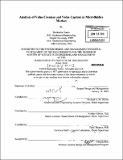Analysis of value creation and value capture in microfluidics market
Author(s)
Yadav, Shailendra
DownloadFull printable version (14.86Mb)
Other Contributors
System Design and Management Program.
Advisor
Michael A. M. Davies, Noubar Afeyan and Todd Thorsen.
Terms of use
Metadata
Show full item recordAbstract
Advances in microfluidics in the last two decade have created a tremendous technological value which is shaping genomics; drug discovery; proteomics; and point-of-care diagnostics. The positive impact has resulted in faster analysis time, increased throughput and reduced cost amongst other important benefits. Yet, the life sciences end-users and the microfluidics players themselves are far from fully capturing the value. Author's own observation based on the experience at a leading genomics research institute, where multiple efforts to implement microfluidics technologies hardly succeeded, supports this fact. The failure to fully capture value has serious implications for the vendors developing microfluidics and the researchers employing these technologies. What are the reasons for this failure? What could be done to increase the value capture? Using well-established management frameworks, such as, s-curve, adopter's distribution model, the thesis studied the nature of value creation and value capture. Survey was used to quantify the impact and the diffusion and adoption of microfluidics technologies, as the respective indicators of value creation and value capture. The data support the insight obtained from the conceptual frameworks that microfluidics is still an immature technology. It also shows that immature technology is the primary reason for lack of full value capture rather than the lack of killer application or niche market - commonly reported reasons in the literature. As an immature technology, microfluidics is thus far still only in the hands of users who are innovators and early adopters - the academic laboratories and the research institutes. The application segments which have seen the most value capture are Genomics and Point-of-care diagnostics. The application segment which has seen the least value capture is Drug discovery. This thesis concludes with the recommendations for short and long term strategies for increasing value capture and accelerating the adoption of microfluidics.
Description
Thesis (S.M. in System Design and Management)--Massachusetts Institute of Technology, Engineering Systems Division, 2010. Cataloged from PDF version of thesis. Includes bibliographical references (p. 63-65).
Date issued
2010Department
System Design and Management Program.; Massachusetts Institute of Technology. Engineering Systems DivisionPublisher
Massachusetts Institute of Technology
Keywords
Engineering Systems Division., System Design and Management Program.